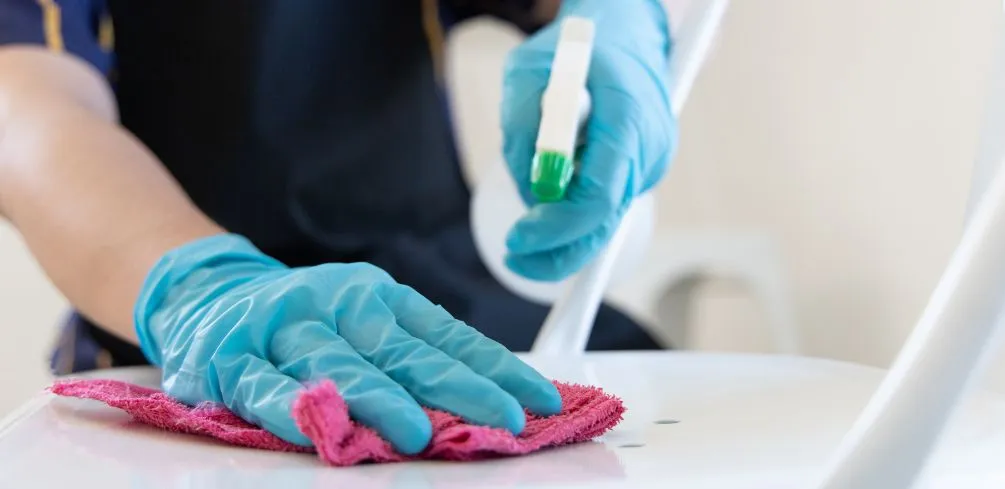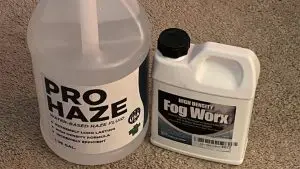Do you have a fog machine? If so, you need to know how to clean the residue it leaves behind. Fog machines are a great way to add excitement and drama to any performance or event.
However, if not cleaned properly, they can leave a mess that is difficult to eliminate. You may be wondering how to clean fog machine residue.
To clean fog machine residue, you must first take the machine outside, empty the reservoir, and then clean it with vinegar and water. Next, rinse it with distilled water. Finally, rinse everything off with clean water.
In this blog post, I will teach you how to clean fog machine residue using simple household items. Follow these steps, and your fog machine will be ready for its next performance.
How to Clean Fog Machine Residue
To clean fog machine residue, you will need the following materials:
- White vinegar
- Water
- Spray bottle
- Lint-free cloth
- A soft brush (optional)
Step-by-Step Instructions on How to Clean Fog Machine Residue
This simple process requires only a few household materials you probably already have. Let’s get started.
Step 1: Take the Machine Outside
You will want to take your fog machine outside for this step. Open a window or door to allow ventilation if you do not have an outdoor space.
The vinegar mixture is stinky, and you don’t want your indoor space to smell like vinegar. Do the cleaning outside next to an outdoor electrical outlet or use a long extension cord.
Step 2: Empty the Tank
Empty the fog machine’s tank of any remaining fluid. You can save this fluid to use later or dispose of it according to your local regulations.
Step 3: Mix the Solution
In a spray bottle, mix equal parts white vinegar and water. Make sure to use distilled water if your tap water is hard.
Tap water contains minerals that can leave spots on your fog machine.
Step 4: Spray the Solution
Generously spray the fog machine with vinegar solution. Be sure to get all sides, including the bottom.
Allow the machine to sit for at least 15 minutes. This will give the vinegar time to break down the residue.
Step 5: Rinse with Distilled Water
Rinse the fog machine with distilled water. You can use a spray bottle or a garden hose. Be sure to remove all of the vinegar solutions.
Step 6: Dry with a Lint-Free Cloth
After the machine has been sitting for at least 15 minutes, use a lint-free cloth to wipe down the exterior. You may need to use a soft brush to get into all the nooks and crannies.
If you see any stubborn residue, spray it again with the vinegar solution and let it sit for a few more minutes.
You can also wipe down the fog machine with a lint-free cloth. If there are any stubborn spots, you can use a soft brush. Allow the machine to air dry completely before storing or using it again.
How to Clean Other Parts of the Fog Machine
The tank and exterior are not the only parts of the fog machine that need to be cleaned. Other parts need to be cleaned as well, such as:
The Nozzle
You need to crap out the nozzle, as this is where most of the residue will be. To do this:
- Mix a solution of one part water and one part vinegar.
- Soak a lint-free cloth in the solution and then use it to wipe down the nozzle. You can also use a soft brush to remove any stubborn residue.
- Rinse the nozzle with distilled water and allow it to air dry.
The Pump
The pump is responsible for circulating the fogging fluid through the machine. It can cause the machine to overheat and break down if it becomes clogged.
To clean it, remove it from the machine and soak it in a vinegar solution for at least 15 minutes. Rinse it with distilled water and let it air dry completely before putting it back in the machine.
Test the Flogger Fluid
Once you have cleaned the fog machine, it is important to test the flogger fluid before using it. This will ensure that the residue has been completely removed and that the machine is functioning properly.
To test the flogger fluid:
- Mix a small amount of water and vinegar in a cup.
- Pour this mixture into the tank and turn on the machine. If the mixture comes out clean, the machine is ready to use.
- If not, repeat the cleaning process.
What Will Happen if You Do not clean Your Fog Machine?
If you do not clean your fog machine, you are most likely going to experience the following problems:
Clogging of the Fluid Heating Chamber
The fluid heating chamber is responsible for vaporizing the fluid. If it becomes clogged with residue, it will not be able to vaporize the fluid properly.
This will cause the machine to overheat and eventually break down.
Loss of Performance
If the nozzle becomes clogged with residue, it will not be able to produce as much fog. This will cause the machine to lose performance and eventually break down.
Overheating of the Heating Element
If the heating element becomes clogged with residue, it will not be able to dissipate heat properly. This will cause the machine to overheat and eventually break down then you will need to unclog the fog machine heater.
Increased Maintenance Costs
If you do not clean your fog machine, you will likely have to replace parts more often. This will increase the maintenance costs of the machine.
Cleaning Fog Machine Residue FAQs
Final Thoughts
Cleaning your fog machine is important if you want it to last many years. To clean the machine, simply mix vinegar and water in a cup and pour it into the tank.
Turn on the machine and let it run for 15 minutes. Rinse with distilled water and allow the machine to air dry completely before using it again.
If you have not cleaned the machine for some time and have got to the point where the fog machine pump is no longer working, here is how to fix it.
I hope this article has helped you learn how to clean fog machine residue. Thanks for reading.
Please be careful and use at your own risk
None of the authors, contributors, administrators, or anyone else connected with Wild Fog, in any way whatsoever, can be responsible for your use of the information contained in or linked from these web pages.











